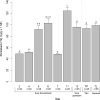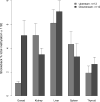Endocrine disruption and differential gene expression in sentinel fish on St. Lawrence Island, Alaska: Health implications for indigenous residents
- PMID: 29182972
- PMCID: PMC5809177
- DOI: 10.1016/j.envpol.2017.11.054
Endocrine disruption and differential gene expression in sentinel fish on St. Lawrence Island, Alaska: Health implications for indigenous residents
Abstract
People living a subsistence lifestyle in the Arctic are highly exposed to persistent organic pollutants, including polychlorinated biphenyls (PCBs). Formerly Used Defense (FUD) sites are point sources of PCB pollution; the Arctic contains thousands of FUD sites, many co-located with indigenous villages. We investigated PCB profiles and biological effects in freshwater fish (Alaska blackfish [Dallia pectoralis] and ninespine stickleback [Pungitius pungitius]) living upstream and downstream of the Northeast Cape FUD site on St. Lawrence Island in the Bering Sea. Despite extensive site remediation, fish remained contaminated with PCBs. Vitellogenin concentrations in males indicated exposure to estrogenic contaminants, and some fish were hypothyroid. Downstream fish showed altered DNA methylation in gonads and altered gene expression related to DNA replication, response to DNA damage, and cell signaling. This study demonstrates that, even after site remediation, contaminants from Cold War FUD sites in remote regions of the Arctic remain a potential health threat to local residents - in this case, Yupik people who had no influence over site selection and use by the United States military.
Keywords: Bering Sea; FUD site; Formerly used defense site; Global distillation; Polychlorinated biphenyls; Yupik.
Copyright © 2017 Elsevier Ltd. All rights reserved.
Conflict of interest statement
Conflicts of interest: none.
Figures






Similar articles
-
Elevated mercury and PCB concentrations in Dolly Varden (Salvelinus malma) collected near a formerly used defense site on Sivuqaq, Alaska.Sci Total Environ. 2022 Jun 20;826:154067. doi: 10.1016/j.scitotenv.2022.154067. Epub 2022 Feb 23. Sci Total Environ. 2022. PMID: 35217049 Free PMC article.
-
Transcriptomic and developmental effects of persistent organic pollutants in sentinel fishes collected near an arctic formerly used defense site.Environ Pollut. 2024 Sep 1;356:124283. doi: 10.1016/j.envpol.2024.124283. Epub 2024 May 30. Environ Pollut. 2024. PMID: 38823546
-
Persistent Organochlorine Pesticide Exposure Related to a Formerly Used Defense Site on St. Lawrence Island, Alaska: Data from Sentinel Fish and Human Sera.J Toxicol Environ Health A. 2015;78(15):976-92. doi: 10.1080/15287394.2015.1037412. J Toxicol Environ Health A. 2015. PMID: 26262441 Free PMC article.
-
Community-based participatory research projects and policy engagement to protect environmental health on St Lawrence Island, Alaska.Int J Circumpolar Health. 2013 Aug 5;72. doi: 10.3402/ijch.v72i0.21656. eCollection 2013. Int J Circumpolar Health. 2013. PMID: 23977641 Free PMC article. Review.
-
Polychlorinated biphenyls (PCBs) as sentinels for the elucidation of Arctic environmental change processes: a comprehensive review combined with ArcRisk project results.Environ Sci Pollut Res Int. 2018 Aug;25(23):22499-22528. doi: 10.1007/s11356-018-2625-7. Epub 2018 Jun 28. Environ Sci Pollut Res Int. 2018. PMID: 29956262 Free PMC article. Review.
Cited by
-
The Origin of a New Sex Chromosome by Introgression between Two Stickleback Fishes.Mol Biol Evol. 2019 Jan 1;36(1):28-38. doi: 10.1093/molbev/msy181. Mol Biol Evol. 2019. PMID: 30272243 Free PMC article.
-
Elevated mercury and PCB concentrations in Dolly Varden (Salvelinus malma) collected near a formerly used defense site on Sivuqaq, Alaska.Sci Total Environ. 2022 Jun 20;826:154067. doi: 10.1016/j.scitotenv.2022.154067. Epub 2022 Feb 23. Sci Total Environ. 2022. PMID: 35217049 Free PMC article.
-
Evaluating Dermal Bone as a Novel Source of Endocrine Information in Ninespine and Threespine Stickleback Fish.Integr Org Biol. 2023 Feb 28;5(1):obad007. doi: 10.1093/iob/obad007. eCollection 2023. Integr Org Biol. 2023. PMID: 36937455 Free PMC article.
-
Exposure to perfluoroalkyl substances and associations with serum thyroid hormones in a remote population of Alaska Natives.Environ Res. 2018 Oct;166:537-543. doi: 10.1016/j.envres.2018.06.014. Epub 2018 Jun 27. Environ Res. 2018. PMID: 29958161 Free PMC article.
-
Protecting the health of future generations in the arctic through community-based participatory research and action.Explore (NY). 2023 Mar-Apr;19(2):271-272. doi: 10.1016/j.explore.2022.12.008. Epub 2023 Jan 2. Explore (NY). 2023. PMID: 36653271 Free PMC article. No abstract available.
References
-
- ADEC. Site report for Northeast Cape. St. Lawrence Island Alaska: Alaska Department of Environmental Conservation Division of Spill Prevention and Response Contaminated Sites Program; 2013a. http://146.63.9.103/Applications/SPAR/PublicMVC/CSP/SiteReport/207.
-
- ADEC. Site summary for Northeast Cape formerly used defense site. Alaska Department of Environmental Conservation Division of Spill Prevention and Response Contaminated Sites Program; 2013b. http://dec.alaska.gov/spar/csp/sites/stlawrence.htm.
-
- Ayotte P, Carrier G, Dewailly E. Health risk assessment for Inuit newborns exposed to dioxin-like compounds through breast feeding. Chemosphere. 1996;32:531–542. - PubMed
MeSH terms
Substances
Grants and funding
LinkOut - more resources
Full Text Sources
Other Literature Sources

